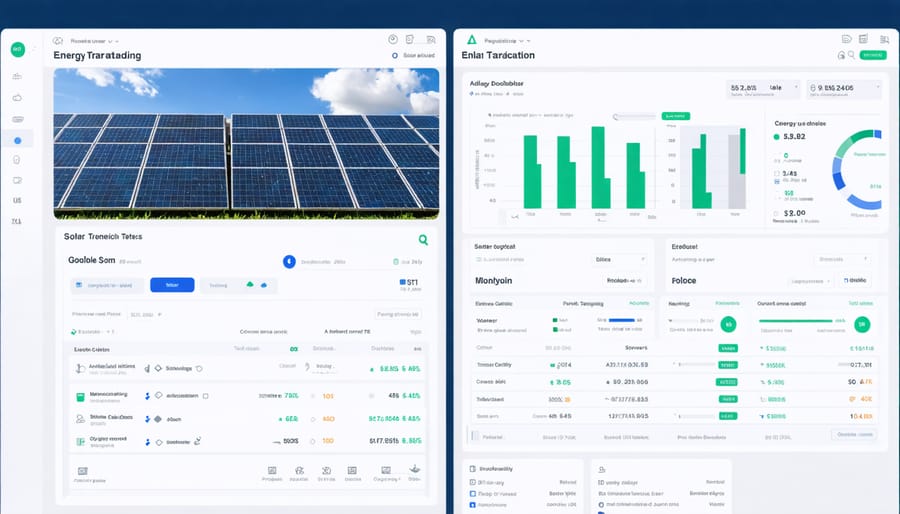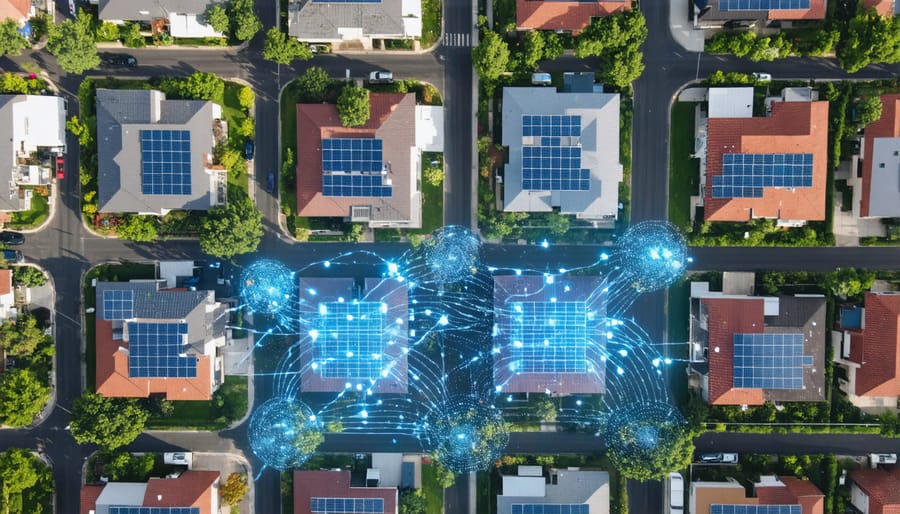Blockchain Energy Trading: How Solar Power Gets Smart (And Saves You Money)
Transform your home’s energy consumption into a smart, profitable asset through blockchain-powered energy trading. This groundbreaking technology enables homeowners and businesses to buy, sell, and exchange renewable energy directly with neighbors, eliminating traditional utility companies as middlemen.
Imagine selling your excess solar power instantly to a nearby business while getting the best market price, all managed automatically through secure, transparent blockchain transactions. This peer-to-peer energy marketplace is already revolutionizing how communities share and monetize clean energy resources.
Beyond simple energy exchange, blockchain energy trading creates a resilient, decentralized power grid that rewards sustainable practices. Smart contracts automatically execute trades based on real-time supply and demand, while immutable ledger technology ensures every transaction is secure and traceable. For homeowners with solar panels, this means turning unused daytime energy into passive income, while businesses can significantly reduce operational costs by purchasing local renewable energy at competitive rates.
As global energy markets evolve, blockchain trading platforms are becoming the foundation of a more democratic, sustainable energy future – one where consumers become active participants in the energy marketplace rather than passive customers of utility monopolies.
How Blockchain Transforms Solar Energy Trading

Peer-to-Peer Energy Trading Explained
Imagine a neighborhood where solar energy flows directly between homes like a digital handshake. That’s exactly what blockchain-enabled peer-to-peer energy trading makes possible, revolutionizing solar energy distribution as we know it. When your solar panels generate more electricity than you need, instead of sending it back to the grid for minimal credit, you can sell it directly to your neighbors at a price that works for both parties.
The process is remarkably straightforward: smart meters track your energy production and consumption in real-time, while blockchain technology securely records every transaction. Think of it as a digital ledger that automatically matches sellers (homes with excess solar power) with buyers (households needing electricity) in your local area. The entire process happens automatically, with smart contracts ensuring instant, secure payments.
This direct trading approach eliminates the middleman, meaning better prices for producers and consumers alike. Plus, by keeping energy local, we reduce transmission losses and strengthen community energy resilience.
Smart Contracts and Automated Trading
Smart contracts are revolutionizing how we trade energy by making transactions automatic, secure, and hassle-free. Think of them as digital agreements that execute themselves when certain conditions are met. For example, when your solar panels generate excess electricity, a smart contract can automatically sell it to your neighbor who needs more power, handling the payment and energy transfer without any paperwork or middlemen.
These self-executing contracts work 24/7, monitoring energy production and consumption in real-time. When you generate surplus solar power during sunny afternoons, the smart contract instantly finds buyers in your neighborhood and completes the transaction at pre-agreed rates. This automation not only saves time but also eliminates the risk of payment disputes or delivery issues.
For homeowners and businesses, this means you can earn money from your excess solar energy without lifting a finger. The system keeps detailed records of all transactions on the blockchain, making them transparent and immutable. Plus, automated trading ensures you get the best possible price for your energy based on current market conditions and demand.
Many users report significant cost savings and increased returns on their solar investments thanks to smart contract automation. It’s like having a personal energy trading assistant working around the clock to maximize your benefits.
Real Benefits for Solar Homeowners
Maximizing Your Solar Investment
Blockchain energy trading opens up exciting new opportunities for solar homeowners to maximize their investment. Instead of receiving a fixed feed-in tariff from your utility company, you can now sell excess solar power directly to neighbors at market-driven prices, often earning significantly more per kilowatt-hour.
For example, during peak demand periods when grid electricity prices are high, you can set competitive rates that are still lower than utility prices but higher than standard solar feed-in tariffs. This win-win situation helps both sellers and buyers while promoting local energy independence.
Smart contracts on the blockchain automatically handle transactions, ensuring you get paid promptly and fairly for every unit of energy you share. The system tracks your solar production, household consumption, and excess energy in real-time, optimizing when to store, use, or sell your power for maximum returns.
To get started, you’ll need a blockchain-enabled smart meter and connection to a local energy trading platform. Many solar installers now offer these as part of their standard packages. The platform’s mobile app lets you monitor your earnings, set pricing preferences, and track your contribution to the community’s renewable energy goals.
Early adopters report earning 30-40% more from their excess solar power compared to traditional feed-in tariffs. As more neighborhoods join these energy trading networks, the potential for returns continues to grow.

Reducing Energy Costs
Blockchain energy trading introduces innovative ways to reduce your energy costs through peer-to-peer transactions and smart contract automation. This technology enables homeowners and businesses to buy and sell excess energy directly, eliminating expensive middlemen and reducing transmission losses.
The system automatically optimizes energy consumption by analyzing usage patterns and market prices in real-time. During peak production hours, excess solar energy can be sold to neighbors at competitive rates, creating a new revenue stream while helping others save money.
Smart contracts ensure transparent pricing and immediate settlements, eliminating billing delays and disputes. Users can set preferences for buying green energy or supporting local producers, making sustainable choices while maintaining cost-effectiveness.
Many homeowners report saving 20-30% on their monthly energy bills after joining blockchain energy networks. The system’s ability to match supply and demand instantly means you’re always getting the best possible rates, whether buying or selling power.
Commercial property managers can particularly benefit from this technology by coordinating energy usage across multiple buildings and automatically redirecting excess power to where it’s needed most, maximizing efficiency and minimizing waste.
Getting Started with Blockchain Energy Trading
Required Equipment and Setup
To participate in blockchain energy trading, you’ll need several key components to get started. First, you’ll need a smart meter that can measure both energy consumption and production in real-time. These meters typically cost between $100-300 and can be installed by a certified electrician.
For solar energy producers, you’ll need a solar inverter with communication capabilities. Modern inverters come with built-in Wi-Fi or ethernet connectivity, allowing them to interface with blockchain platforms. Make sure your inverter is compatible with your chosen energy trading platform.
A stable internet connection is essential, as blockchain energy trading requires constant connectivity to monitor and execute transactions. Consider installing a backup internet solution to ensure uninterrupted trading capabilities.
On the software side, you’ll need to set up a digital wallet to manage your energy tokens or credits. Most platforms provide their own wallet applications, which can be downloaded from official websites or app stores. You’ll also need to install the energy trading platform’s software, which serves as your interface for buying and selling energy.
For enhanced security, consider investing in a hardware security key ($20-50) to protect your digital wallet. Some platforms may require additional security measures, such as two-factor authentication apps on your smartphone.
Don’t forget about the basics: a computer or smartphone with sufficient processing power to run the trading platform, and enough storage space for transaction records. Most modern devices meet these requirements, but verify compatibility with your chosen platform before getting started.
Remember to check local regulations and obtain any necessary permits before setting up your system. Some jurisdictions may require specific certifications or inspections for peer-to-peer energy trading participation.
Choosing a Trading Platform
When it comes to blockchain energy trading, choosing the right platform is crucial for success. Several established platforms cater to different needs, from residential solar panel owners to large commercial properties. The key is finding one that matches your specific requirements and technical comfort level.
Popular platforms like Power Ledger and WePower offer user-friendly interfaces and have proven track records in facilitating peer-to-peer energy trading. Grid+ focuses on seamless integration with existing smart meters, while Energy Web Foundation provides a more comprehensive solution for larger operations.
When selecting a platform, consider these essential factors:
– Ease of use: Look for intuitive interfaces that don’t require extensive technical knowledge
– Community size: Larger user communities often mean more trading opportunities
– Integration capabilities: Ensure the platform works with your existing solar setup
– Security features: Verify the platform’s security protocols and transaction protection
– Support services: Check the availability of customer support and educational resources
– Transaction fees: Compare costs across platforms to maximize your trading profits
Many platforms offer free trials or demo versions, which are excellent ways to test their features before committing. Start by exploring these demo versions to get a feel for the interface and trading process. Remember to read user reviews and possibly connect with current users in your area to learn from their experiences.
Consider your long-term goals as well. Some platforms offer additional features like energy consumption analytics or automated trading options that might become valuable as you become more experienced with energy trading.
Future of Solar Energy Trading

Community Solar Projects
Blockchain technology is revolutionizing the way neighborhoods share and distribute solar energy through innovative community solar energy sharing projects. These initiatives allow residents to participate in local solar power generation and distribution, even if they can’t install panels on their own roofs.
Here’s how it works: Multiple households in a neighborhood contribute to a shared solar installation, whether it’s on a community center, shared space, or distributed across multiple properties. The blockchain platform tracks each participant’s contribution and energy consumption in real-time, ensuring fair distribution and compensation.
For example, when the Jones family generates excess solar power during sunny afternoons, the blockchain automatically records this surplus and allows the Smiths next door to purchase it using digital tokens. This peer-to-peer trading happens instantly, without the need for intermediaries, reducing costs for everyone involved.
The benefits extend beyond individual households. Community solar projects powered by blockchain create resilient neighborhood microgrids, reduce dependency on the main power grid, and foster a stronger sense of community. Participants can monitor their energy production and consumption through user-friendly mobile apps, making it easy to track savings and environmental impact.
Many communities are already seeing success with these projects, reporting average energy cost reductions of 15-30% while significantly decreasing their carbon footprint. As more neighborhoods adopt this model, we’re witnessing the emergence of a more sustainable and democratized energy future.
Grid Integration
The future of blockchain energy trading lies in its seamless integration with existing power grids, a development that’s already taking shape across several innovative pilot projects. Smart meters equipped with blockchain capabilities are being installed in communities, creating a bridge between traditional grid infrastructure and peer-to-peer energy markets.
Grid operators are working on standardized protocols that will allow blockchain-based energy trading platforms to communicate directly with grid management systems. This integration enables real-time monitoring of energy supply and demand, automatic adjustment of power distribution, and instant settlement of transactions.
For homeowners and businesses, this means your excess solar energy can be automatically sold to the grid when prices are most favorable, while smart contracts ensure you receive fair compensation. The system can even predict peak demand periods and adjust your energy storage strategy accordingly.
Several utilities are now testing blockchain-enabled grid management systems that can handle thousands of micro-transactions per second. These systems maintain grid stability while maximizing the benefits of distributed energy resources. As this technology matures, we’re likely to see more grid operators adopting blockchain solutions to manage the increasing complexity of renewable energy integration.
The next five years will likely bring more sophisticated grid integration features, including automated demand response programs and dynamic pricing mechanisms that benefit both consumers and utilities.
Blockchain energy trading represents a transformative shift in how we think about and manage our energy resources. As we’ve explored throughout this article, this innovative technology empowers homeowners and businesses to take control of their energy future while contributing to a more sustainable world. The potential benefits are clear: reduced energy costs, increased grid reliability, and the ability to monetize excess renewable energy production.
The time to act is now. With climate change concerns mounting and energy costs rising, implementing blockchain-based energy trading systems offers a practical solution that benefits both individual participants and the broader community. Whether you’re a homeowner with existing solar panels or someone considering investing in renewable energy, blockchain technology provides the framework for maximizing your investment while supporting the transition to clean energy.
Getting started is easier than you might think. Begin by assessing your current energy setup, consulting with local renewable energy providers, and exploring available blockchain energy trading platforms in your area. Remember that early adopters often gain the most significant advantages as these systems become more widespread.
By embracing blockchain energy trading, you’re not just making a smart financial decision – you’re joining a growing movement of forward-thinking individuals who are actively shaping the future of energy distribution. Together, we can create a more resilient, efficient, and sustainable energy ecosystem for generations to come. Take the first step today and become part of the energy revolution.











